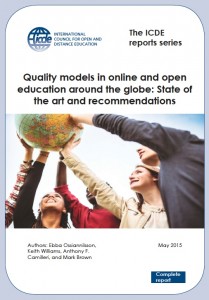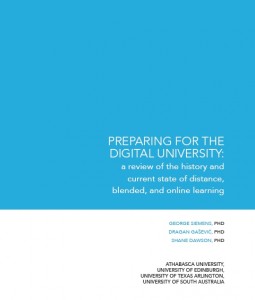It just won’t go away, will it: the relentless focus and the ever-growing ‘industry’ of quality. It’s right across the higher education spectrum, of course, with its tentacles reaching inexorably into the world of open and distance learning. Please don’t think I’m anti-quality – it’s just that it gets tiresome at times, and some of the procedures and policies can detract us from other more directly teaching-focussed activities (a polite way of saying that quality incursions can be irritating and possibly irrelevant).
 So it’s with these thoughts in mind that I present to you a recent report from the ICDE: ‘Quality models in online and open education around the globe: State of the art and recommendations‘. Published in May 2015, it’s a joint effort of the ICDE and leading ODL practitioners around the globe, including worthy representatives from both CoL and Australia. And while I’m being a bit picky, I don’t know how the phrase ‘state of the art’ in the title got past the authors and editors: it’s clichéd and trite. Surely ‘current status’ is better?
So it’s with these thoughts in mind that I present to you a recent report from the ICDE: ‘Quality models in online and open education around the globe: State of the art and recommendations‘. Published in May 2015, it’s a joint effort of the ICDE and leading ODL practitioners around the globe, including worthy representatives from both CoL and Australia. And while I’m being a bit picky, I don’t know how the phrase ‘state of the art’ in the title got past the authors and editors: it’s clichéd and trite. Surely ‘current status’ is better?
Anyway, the good things: it’s a clear and competent overview of the quality issue as it pertains to online and open education. It’s also not too long – 52 pages. Different bits will appeal to different people, and overall it’s well worth a browse to get you up to date with current thinking. For example, if you’re new to the issue, you’ll find sections 3.2 to 3.8 highly informative.
The recommendations are sound, though neither surprising nor particularly exciting:
- Mainstream e-learning quality into traditional institutional quality assurance;
- Support the contextualisation of quality systems;
- Support professional development, in particular through documentation of best practice and exchange of information;
- Communicate and promote general principles;
- Assist institutions in designing a personalised quality management system;
- Address unbundling and the emergence of non-traditional educational providers;
- Address quality issues around credentialisation through qualifications frameworks;
- Support knowledge transfer from open and distance learning to traditional quality systems;
- Support quality assurance audits and benchmarking exercises in the field of online, open, flexible, e-learning and distance education;
- Encourage, facilitate and support research and scholarship in the field of quality; and
- Encourage, facilitate and support implementing quality assurance related to new modes of teaching.
 So there you go. But while we’re at it, I’d like to point you to another publication, referenced in the above report. It’s a research report coming from Athabasca University and part-funded by the Bill and Melinda Gates Foundation: ‘Preparing for the digital university: a review of the history and current state of distance, blended, and online learning‘. A more substantial publication (234 pages), it covers a lot of ground, though most of the attention it’s received so far focusses on the section dealing with the dreaded MOOCs. The overall intent is clear from the authors:
So there you go. But while we’re at it, I’d like to point you to another publication, referenced in the above report. It’s a research report coming from Athabasca University and part-funded by the Bill and Melinda Gates Foundation: ‘Preparing for the digital university: a review of the history and current state of distance, blended, and online learning‘. A more substantial publication (234 pages), it covers a lot of ground, though most of the attention it’s received so far focusses on the section dealing with the dreaded MOOCs. The overall intent is clear from the authors:
It is our intent that these reports will serve to introduce academics, administrators, and students to the rich history of technology in education with a particular emphasis of the importance of the human factors: social interaction, well-designed learning experiences, participatory pedagogy, supportive teaching presence, and effective techniques for using technology to support learning.
I’ve only skimmed it so far, and it’s pretty solid stuff, though the history bits are just brief summaries (the references will show you where to go for more, of course). And if you are limited in time, then I suspect the best part to read is from p. 199: ‘Future Technology Infrastructures for Learning’.
Go to it.